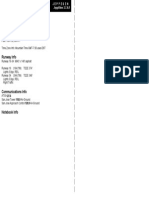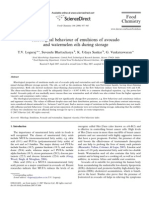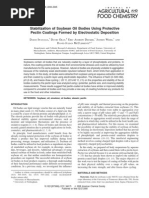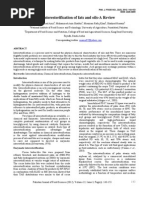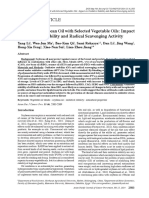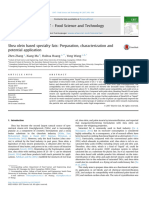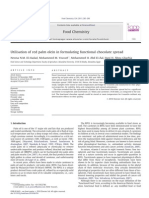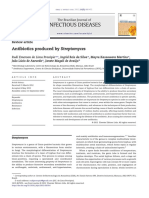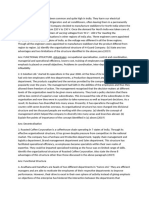Food Hydrocolloids: Peter Chivero, Shoichi Gohtani, Hidefumi Yoshii, Akihiro Nakamura
Food Hydrocolloids: Peter Chivero, Shoichi Gohtani, Hidefumi Yoshii, Akihiro Nakamura
Uploaded by
Cruz-ClaraCopyright:
Available Formats
Food Hydrocolloids: Peter Chivero, Shoichi Gohtani, Hidefumi Yoshii, Akihiro Nakamura
Food Hydrocolloids: Peter Chivero, Shoichi Gohtani, Hidefumi Yoshii, Akihiro Nakamura
Uploaded by
Cruz-ClaraOriginal Title
Copyright
Available Formats
Share this document
Did you find this document useful?
Is this content inappropriate?
Copyright:
Available Formats
Food Hydrocolloids: Peter Chivero, Shoichi Gohtani, Hidefumi Yoshii, Akihiro Nakamura
Food Hydrocolloids: Peter Chivero, Shoichi Gohtani, Hidefumi Yoshii, Akihiro Nakamura
Uploaded by
Cruz-ClaraCopyright:
Available Formats
Physical properties of oil-in-water emulsions as a function of oil
and soy soluble polysaccharide types
Peter Chivero
a
, Shoichi Gohtani
b,
*
, Hidefumi Yoshii
b
, Akihiro Nakamura
c
a
Department of Food Science, The United Graduate School of Agricultural Sciences, Ehime University, 2393 Kitagun, Mikicho, Ikenobe 761-0795, Japan
b
Department of Applied Biological Sciences, Faculty of Agriculture, Kagawa University, 2393 Kitagun, Mikicho, Ikenobe 761-0795, Japan
c
New Business Development Division, Fuji Oil Co., Ltd., West Tower, Sumimoto Fudosan Mita Twin Building, 3-5-27 Mita, Minato-ku, Tokyo 108-6323, Japan
a r t i c l e i n f o
Article history:
Received 24 July 2013
Accepted 9 December 2013
Keywords:
Soy soluble polysaccharide (SSPS)
Perilla seed oil (PSO)
Palm kernel oil (PKO)
n-Hexadecane
Rheology
a b s t r a c t
Soy soluble polysaccharide (SSPS), extracted from the by-product of soy protein isolation, has been
widely established as an emulsier for oil-in-water (O/W) emulsions. Impact of the type of SSPS (i.e.
SSPS-L; SSPS-M; and SSPS-H differentiated by their respective extraction conditions) and the type of oil
(i.e. Perilla seed oil e PSO; palm kernel oil e PKO; and n-Hexadecane) was examined through analysis of
the differences in average droplet diameter, droplet size distribution (DSD) and emulsion rheological
properties. Oil/water interfacial tension strongly depended on SSPS type. SSPS-L was the most capable in
reducing interfacial tension against PSO, PKO and hexadecane followed by SSPS-M and lastly SSPS-H.
Irrespective of oil type, at 20% oil content, SSPS-L and M were better emulsiers for achieving small
droplets due to their high protein content. Both SSPS (types L and M) solutions and their respective
emulsions regardless of oil type exhibit Newtonian ow behavior while SSPS-H solution and the
respective emulsions show shear-thinning behavior. Emulsion viscosity was inuenced by both SSPS and
oil types with SSPS-H and hexadecane producing high viscosity emulsions. This paper provides impor-
tant information on the performance of different types of SSPS against different types of oils which can
be used in formulating food and beverage systems.
2014 Elsevier Ltd. All rights reserved.
1. Introduction
Water-soluble soybean polysaccharide (SSPS) has recently
received a lot of attention in the food industry due to its emulsi-
fying capabilities. SSPS has been named a better emulsier than
gum Arabic since less concentration is required to stabilize emul-
sions compared to its counterparts (Nakamura, Takahashi, Yoshida,
Maeda, & Corredig, 2004). SSPS is extracted by hot water from
soybean residue after the extraction of soy milk, soy protein and soy
oil. Molecular weight, composition and functionality of SSPS are
affected by changes in the extraction conditions. With regards to
emulsication ability, Nakamura et al. (2004) found that SSPS-L,
which has the lowest molecular mass distribution, has a higher
emulsifying capacity compared to SSPS-M and SSPS-H. This was
attributed to the low molecular mass of SSPS-L and the high
amount of protein such that SSPS-L would easily adsorb at the
interface than the higher molecular weight SSPS-M and SSPS-H,
with low protein content. In the present study, the sample
referred to as SSPS-H is different from the one referred to in pre-
vious literature (Nakamura et al., 2004). In an effort to produce a
better type of SSPS, new extraction conditions were used for the
present type of SSPS-H. Apart from analyzing the differences in
emulsion systems made from different types of oils, we are also
reporting comparisons of the new SSPS-H and the already estab-
lished SSPS-L and -M.
In an emulsion system, surface active agent or thickeners are
contained in the water phase while they cover the oil surfaces and
inadvertently induce specic rheological properties such that
physical separation is avoided (Taherian, Fustier, & Ramaswamy,
2006). Modication of the particle size distribution and rheolog-
ical properties of the continuous phase, arising from the surface
active hydrocolloid or thickener, plays an important role on the
nal product quality. The characteristics of the dispersed phase are
also of major importance. This is because the characteristic
appearance and rheology of food emulsions is largely a result of the
immiscibility of oil and water, since this leads to a systemwhere the
* Corresponding author. Tel./fax: 81 87 891 3103.
E-mail addresses: pchivero@yahoo.com (P. Chivero), gohtani@ag.kagawa-u.ac.jp
(S. Gohtani), foodeng.yoshii@ag.kagawa-u.ac.jp (H. Yoshii), nakamura.akihiro@so.
fujioil.co.jp (A. Nakamura).
Contents lists available at ScienceDirect
Food Hydrocolloids
j ournal homepage: www. el sevi er. com/ l ocat e/ f oodhyd
0268-005X/$ e see front matter 2014 Elsevier Ltd. All rights reserved.
http://dx.doi.org/10.1016/j.foodhyd.2013.12.017
Food Hydrocolloids 39 (2014) 34e40
droplets of one phase are dispersed in the other (McClements,
2005). Some types of oil have signicantly different properties
from the majority of other oils, which may appreciably inuence
their functional characteristics in emulsions. Furthermore, the
stability of emulsions is strongly inuenced by the hydrophobicity
of the oil phase and the molecular volume of the oil (Knoth, 2005).
Wide research has been conducted on the emulsication ability
of SSPS but less attention has been given on the effects of SSPS as a
sole stabilizer and an emulsier on the rheological properties of
emulsions. Most studies have been conducted using easily emul-
sied oils, like soybean oil. The emulsifying behavior of SSPS in a
wide variety of oils has not yet received much attention. In the
current study, three characteristically different oils, palm kernel oil
(PKO) which is classied as a medium chain triglyceride, Perilla
seed oil (PSO) from genus Perilla frutescens, and n-Hexadecane,
were used in emulsion systems stabilized by three types of SSPS
(SSPS-L, SSPS-M, and SSPS-H), differentiated by their extraction
conditions. Since hexadecane is highly puried oil with known
chemical structure, it was used as a simple model system to facil-
itate interpretation of experimental data and compare these data to
real food emulsions. The overall objective of the current research
was to determine the inuence of both oil and SSPS emulsier
types on the properties of oil-in-water (O/W) emulsions. Emulsions
were characterized in terms of average droplet diameter, droplet
size distribution (DSD) and rheological properties. Instead of using
different terminology such as average droplet diameter, emulsion
droplet size, droplet size etc., which may become confusing,
emulsion droplet size (EDS), will be used in the rest of this paper.
2. Experimental
2.1. Materials
SSPS, type SSPS-L, -M and -H, was obtained fromFuji Oil Co. Ltd.
(Tokyo, Japan). Perilla seed oil (PSO) from genus P. frutescens con-
taining 60 g of a-linolenic acid, 13 g of linoleic acid, and 14 g of oleic
acid, was purchased froma conventional retail shop. Palmkernel oil
(PKO) of _99.9% triglyceride content (C6 e 0.3%; C8 e 81.6%; C10 e
17.4%; and C12 e 0.4%) was purchased from Kao Chemicals (Tokyo,
Japan). Analytical grade sodium azide (NaN
3
) antimicrobial and n-
Hexadecane oil were purchased fromNacalai Tesque (Kyoto, Japan).
Puried water was prepared using a Barnstead E-pure system
(Dubuque, USA).
2.2. Preparation of SSPS
SSPS-L and -M were prepared using the method of Nakamura
et al. (2004). SSPS-L and M were extracted from okara (soybean
residue after extraction of oil and protein) using hot water by
heating at 120
C, pH 3.0 for 2 h and 120
C, pH 4.0e5.0 for 2 h,
respectively. Insoluble materials were then removed by centrifu-
gation and the extract was desalted by electric dialysis before being
spray dried. The sample named SSPS-H in this paper was prepared
using the method of Nakamura, Fujii, Tobe, Adachi, and Hirotsuka
(2012). Okara was heated at 120
C at pH 4.0 for 2 h. Insoluble
residue was then centrifuged out, desalted and then concentrated
by a rotary evaporator to 20%w/w before being freeze-dried.
2.3. Interfacial tension
Interfacial tension of the three types of oil (PKO, PSO and hex-
adecane) against pure water and SSPS (1%wt.) were measured by
means of a drop volume method employing a computer controlled
apparatus (DVS-2000, Yamashita Giken, Japan) at 25
C. The re-
ported values are averages of three independent readings.
2.4. Preparation of emulsions
SSPS was thoroughly dissolved using magnetic stirrers in
distilled water containing 0.02% sodium azide as an antimicrobial.
The pHof SSPS dispersions was 5.50, 5.10, and 6.57 for SSPS-L, SSPS-
M, and SSPS-H, respectively. Respective oil was added to the SSPS
solutions and then pre-homogenized using Ultra-Turrax T25 (Janke
& Kunnel, IKA Labortechnik, Germany) for 5 min at 15 000 rpm.
SSPS solutions and oil were mixed to obtain a nal concentration of
20%wt oil and variable concentrations of 3e8%wt SSPS. O/W
emulsions were prepared using a laboratory scale two-step ho-
mogenizer, LAB-2000 (APV-Gualin, USA) with four passes. The
homogenizationpressure was set at a total pressure of 40 MPa, with
10% of the total pressure maintained in the second stage to avoid re-
coalescence. For evaluation of the effect of homogenization pres-
sure, experiments were carried out at two more homogenization
pressures set at 60 MPa and 80 MPa. The pH of the nal emulsions
was the same as their respective SSPS solution dispersions since
the oil had little inuence on the solution pH. No pH adjustments
were made to the nal emulsions. Emulsion preparation was
repeated three times and averages for all treatments are reported as
results.
2.5. Evaluation of emulsions
The EDS and the DSD was determined using a laser diffraction
particle size analyzer SALD-3000 (Shimadzu Co., Ltd, Japan). Data
was analyzed using an installed software Wing SALD-3000J to
determine the EDS (d
3,2
) and the DSD patterns. The diluted emul-
sions were measured approximately 2 h after preparation and at
specied days during storage for 2 weeks. Microscopic images were
taken using uorescence microscope BX51 (Olympus, Japan).
2.6. Viscosity measurements
Rheological properties of completely dissolved SSPS solutions
and O/W emulsions stabilized by SSPS were evaluated. Low vis-
cosity samples were measured at 25
C using cone and plate
viscometer DV-III Ultra (Brookeld, USA) at an angle and gap be-
tween the cone and plate of 0.8
and 13.0 mm, respectively. Samples
of high viscosity were measured using viscometers TV-20 or TV-30
(Toki Sangyo Co. Ltd, Japan) using standard cones. The angle and
the gap between the cone and plate for both machines were 1
34
/
and 12.5 mm, respectively. After equilibrating the samples to 25
C,
the shear stress and viscosity readings were collected at each shear
rate point after subjecting the sample to shear for 60 s. Due to the
existence of some yield stress, when the data were tted to
experimental models, all experimental data indicated a correlation
coefcient of _0.98 when tted to HerscheleBulkley model which
is represented by the equation shown below:
s = s
o
kg
n
; (1)
where s is the shear stress (Pa), s
o
is the yield stress (Pa), g is
the shear rate (s
1
), n is the dimensionless owbehavior index, and
k is the consistency index (Pa s
n
). The HerscheleBulkley model was
therefore used to estimate the rheological parameters calculated
using the solver method. Data are reported as SD of triplicates.
2.7. Statistical analysis
ANOVA and Duncan tests were carried out on different param-
eters to distinguish signicant differences caused by either emul-
sier or oil type. SPSS, version 19 (IBM, USA) statistical software
package was used.
P. Chivero et al. / Food Hydrocolloids 39 (2014) 34e40 35
3. Results and discussions
3.1. Interfacial activity of SSPS
Emulsion formation and stability depends on several factors
including oil interfacial tension which determines the ease of
droplet disruption during homogenization (Rao & McClements,
2012). In Fig. 1, PKO and PSO had similar interfacial tension
against water or any type of SSPS while on the other hand hex-
adecane had signicantly high interfacial tension against both
water and SSPS compared to PKOand PSO. The interfacial tension of
oil/water systems were measured and found to be around 25 mN/m
for both PKO and PSO while it was around 52 mN/mfor hexadecane
(Fig. 1). The considerably higher interfacial tension of hexadecane
compared to PKO or PSO indicates that the Laplace pressure
opposing droplet deformation and disruption is higher for hex-
adecane (McClements, 2005), such that the EDS would be expected
to be bigger when hexadecane is used as the dispersed phase in
emulsion systems compared to PKO or PSO. The effect of the three
types of oil on the interfacial tension against the three different
types of SSPS is also seen in Fig. 1. Compared to the tension at the
oil/water interface, all the three types of SSPS were able to signif-
icantly reduce the interfacial tension, indicating the capability of
SSPS to adsorb at the interface. Among the three types of SSPS,
SSPS-L is superior to SSPS-M or SSPS-H especially against hex-
adecane, and SSPS-His the least capable emulsier against all three
types of oil. This may be caused by the difference in the amount of
protein (Table 1) which plays an important adsorption role at the
interface and also the conformation of the sugar chains of SSPS.
3.2. Emulsication behavior of SSPS in different types of oil
Emulsions containing varying concentrations of SSPS were
prepared with PKO, PSO and hexadecane. Fig. 2 shows the EDS of
emulsions stabilized with SSPS-L, SSPS-M, and SSPS-H. The emul-
sions were prepared at a constant concentration of oil (20%) irre-
spective of the type of the oil or emulsier. At an SSPS
concentration of 6%wt and above, emulsions containing dispersed
phases of both PKO and PSO stabilized by SSPS-L or SSPS-M had
similar EDS as shown in Fig. 2 (a & b). The EDS were about 0.7 mm
and 0.8 mm for SSPS-L or -M/PSO and SSPS-L or -M/PKO emulsion
systems, respectively. Further increase in the concentration of SSPS
did not change the EDS indicating that a concentration of 6%wt
SSPS-L or -M is the optimum required to completely cover the oil
droplet surface of emulsions containing PKO or PSO as the
dispersed phase.
A continuously decreasing trend of EDS for SSPS/hexadecane
emulsion systems was observed with increasing SSPS concentra-
tions. Regardless of the type of SSPS, the optimum amount of SSPS
required to make the smallest hexadecane O/W emulsion droplets
surpassed 8%wt. Emulsions with concentrations of SSPS above 8%
wt were extremely difcult to make due to high viscosity of the
SSPS solution. In SSPS-H/PKO or PSO emulsion systems, the EDS
were independent of the concentration of SSPS, especially for PKO.
An almost constant average droplet size of about 2 mm was ob-
tained at all concentrations of SSPS-H as shown in Fig. 2(c). Over-
ally, a close relationship was observed between the tension at the
oil/SSPS interface and the resulting EDS. PKO and PSO had similar
interfacial tension values against each type of emulsier (SSPS-L, M,
or H) and subsequently the EDS of systems containing PKO or PSO
were somewhat similar for each SSPS emulsier. Even though the
chain lengths of the constituent triglycerides in PKO and PSO are
different (predominantly 8 and 10-carbon chain for PKO and 18-
carbon chain for PSO), the behavior of PKO and PSO with SSPS
emulsier was similar, indicating that the chain length for these oils
Fig. 1. The interfacial tension between three types of oil (PKO; PSO; & hexadecane) and
water or 1%wt. SSPS solution (SSPS-L; -M; or -H) measured at 25
C.
Table 1
Monosaccharide compositions of different types of soybean polysaccharide (SSPS).
Type of SSPS Sugar composition (mol %) Protein (dry %)
Rha Fuc Ara Gal Xyl Glc GalA
SSPS-L
a
4.3 1.5 15.3 48.3 1.5 1.6 27.5 8.2
SSPS-M
a
4.1 2.4 20.1 47.2 1.2 1.1 23.9 5.9
SSPS-H
b
2.5 1.1 21.0 43.7 6.4 5.4 19.9 5.1
Rhamnose (Rha), Fucose (Fuc), Arabinose (Ara), Galactose (Gal), Xylose (Xyl),
Glucose (Glc), Galacturonic acid (GalA).
a
Nakamura et al., 2004.
b
Nakamura et al., 2012.
Fig. 2. EDS of O/W emulsion containing 20% oil concentration plotted as a function of the concentration of SSPS. The type of SSPS is presented as (a): SSPS-L; (b): SSPS-M; and (c):
SSPS-H. The legend shows the type of the dispersed phase for each respective emulsion system. The EDS were measured approximately 2 h after preparation of fresh emulsions.
P. Chivero et al. / Food Hydrocolloids 39 (2014) 34e40 36
has negligible effect in emulsion formation. On the other hand, the
obviously high interfacial tension (compared to those of PSO or
PKO) values of hexadecane against all types of SSPS corresponded
to bigger EDS for all emulsion systems prepared in this study,
making hexadecane characteristically different from PSO or PKO.
For all the types of oil used with all three types of SSPS, emulsion
stability was maintained over 14 days of storage at 25
C, especially
at concentrations of SSPS of more than 5%wt. Selected cases, for
example SSPS-L/PKO and SSPS-H/hexadecane emulsions showed
that 3 or 4%wt SSPS was not enough to stabilize emulsions for 14
days. The average droplet sizes increased and the droplet distri-
bution moved to bigger droplet sizes (results not shown).
DSD is named as one of the most important parameters for
characterizing emulsions because this property is directly linked to
stability, creaming-resistance, rheology, and chemical reactivity
(Anihouvi, Danthine, Kegelaers, Dombree, & Blecker, 2013).
Fig. 3(a1, 2 & 3) shows the DSDfor freshly prepared emulsions. In all
the prepared formulations, uni-, bi- or trimodal DSD existed and in
some cases, broad DSD were observed. The representative micro-
structure (SSPS-H stabilized emulsion systems) of emulsions
observed under the microscope shown in Fig. 3 (b1, 2 & 3) clearly
shows the presence of polydisperse distribution of droplet size in
the emulsion. The broad and multimodal DSD observed in SSPS
stabilized emulsion systems could be attributed to the interfacial
adsorption rate of SSPS emulsier and also the type of homogenizer
used. Jafari, Assadpoor, He, and Bhandari (2008) reviewed that in
high pressure homogenization systems, the DSD can be wide or
bimodal so that a small fraction of droplets will have a much bigger
size than the mean EDS.
3.3. Effect of homogenization pressure
In an effort to obtain much smaller EDS of less than 0.7 mmat the
same total oil content in the emulsion system, high pressures for
homogenization were used. This is because, it has been well
established that during high pressure homogenization of liquid
dispersions, high shear, turbulent and/or cavitational forces
simultaneously act on the dispersed phase to reduce the average
droplet diameter (McClements, 2005). Moreover, during homoge-
nization the proteins adsorb from the continuous phase to the
Fig. 3. DSD curves (a) and representative micrographs (b) at 100 magnication of freshly prepared O/Wemulsions containing 6%wt. of SSPS and 20%wt. oil. The emulsion systems
are stabilized by: (a1) SSPS-L; (a2) SSPS-M; and (a3) SSPS-H. The DSD curves are averages of three replications with a maximum standard deviation of 0.3 mm.
Fig. 4. The effect of homogenization pressure on O/Wemulsions containing 6%wt SSPS and 20%wt oil. The droplet sizes were measured approximately 2 h after preparation of fresh
emulsion. The emulsier type in each emulsion system is presented as: (a) SSPS-L; (b) SSPS-M; and (c) SSPS-H.
P. Chivero et al. / Food Hydrocolloids 39 (2014) 34e40 37
newly formed oil surface against droplet occulation and coales-
cence, thus limiting the phase separation and providing with a
longer shelf life and better texture (Long, Zhao, Zhao, Yang, & Liu,
2012). Higher pressures of homogenization were therefore ex-
pected to further increase the surface area of the emulsifying
molecules and result in smaller EDS. In Fig. 4(a), SSPS-L/PSO or PKO
emulsions were not affected by any increase in the homogenization
pressure. However, for SSPS-L/hexadecane emulsions, a slight
decrease at 60 MPa was noticed although the droplets later became
bigger when homogenized at 80 MPa. An increase in the homog-
enization pressure also resulted in an increase in EDS for SSPS-M/
PSO or PKO emulsions in Fig. 4(b) and all emulsion systems in
Fig. 4(c). Among all the prepared emulsion systems, only SSPS-M/
hexadecane emulsions show an expected decreasing trend with
increasing homogenization pressure. High pressure increased the
emulsifying capacity of SSPS-M toward hexadecane.
In all the emulsion systems where higher homogenization
pressure resulted in bigger EDS, we presume that the newly created
droplets of emulsions immediately coalesced at the exit of the
homogenization valve as the homogenization pressure increased.
The representative microscopic pictures in Fig. 5 clearly show the
difference in the EDS of emulsions stabilized by SSPS-H. This phe-
nomenon was thought to be caused by over-processing. This can
occur during high pressure homogenization if the timescale of
emulsier absorption is longer than the timescale of droplete
droplet collision. The fresh interface will not be completely covered
by the emulsier and leads to droplet re-coalescence ultimately
resulting in an increase in the EDS. This means that although the
energy input during emulsication has been increased, the ob-
tained emulsions have bigger droplet sizes rather than the expected
smaller sizes (Jafari et al., 2008).
Rhamno-galacturonans or pectic substances (back bone of SSPS)
are known to have a strong tendency to aggregate in solution
depending on method of extraction and concentration. Upon high
pressure homogenization, the aggregates are disrupted by shear
forces (Wicker, Corredig, & Kerr, 2000), resulting in a decrease in
the viscosity and molecular weight. These structural changes may
affect the stabilizing ability of the polysaccharide. In light of this
behavior, the marked increase (p < 0.05) of EDS with increase in
homogenization pressure especially for emulsion systems stabi-
lized by SSPS-H was also thought to be related to aggregate
disruption of SSPS emulsier. In order to conrmthis phenomenon,
SSPS-H solutions were dissolved in water and homogenized at the
above discussed homogenization pressures. The resulting solutions
were measured for their ow behavior and viscosity using the
methods described for measuring emulsion viscosity. The apparent
viscosity of native SSPS-H solution (6%wt) was signicantly high
(29.67 mPa s) compared to the apparent viscosity (17.65 mPa s) of
the 80 MPa homogenized solution measured at a shear rate of
191.5 s
1
as shown in Table 2. A decrease was noticed in the con-
sistency index, k, with an increase in the homogenization pressure
while the slightly shear-thinning behavior of native SSPS-H solu-
tion became Newtonian at all homogenization pressures.
Intrinsic viscosity, [h], was also calculated in order to conrm
the structural changes in SSPS. [h] is a convenient way to charac-
terize changes in polymer dimensions since it is dened as a
measure of the hydrodynamic volume occupied by the individual
polymer molecules (Richardson & Kasapis, 1998). The [h] (dL/g) of a
polymer is calculated by the formula:
[h[ = lim
c/0
h
sp
=c
= lim
c/0
(ln(h
rel
=c)); (2)
where h
sp
is specic viscosity, h
rel
is relative viscosity, and c is the
concentration of the polysaccharide. The [h] markedly decreased at
40 & 60 MPa compared to the native and was less affected by
80 MPa of homogenization. The change in SSPS polymer dimension
as suggested by the change in [h] is reected by the way the
apparent viscosity changed as mentioned above. SSPS-H solution
showed Newtonian behavior and a marked decrease in [h] after
being homogenized (Table 2) conrming the disruption of SSPS-H
chain aggregates. Due to these structural changes, the residence
Fig. 5. Representative micrographs (x100) taken approximately after 2 h of preparation of O/W emulsions containing 6%wt SSPS-H and 20%wt PKO showing the effect of high
pressure homogenization on the stabilizing capacity of SSPS-H.
Table 2
The rheological parameters of 6% SSPS-H solution between 7 and 450 s
1
of shear stress using the HerscheleBulkley model.
Treatment of sample HerscheleBulkley factors h at 191.5 s
1
[h]
s
o
k n
(Pa) (Pa s
n
) (e) (mPa s) (dL/g)
Unhomogenized 0.112 0.0133
a
0.042 0.0004
c
0.93 0.01
a
29.67 0.73
c
0.80 0.01
c
40 MPa 0.110 0.0048
a
0.019 0.0003
b
1.00 0.00
b
19.72 0.03
b
0.70 0.02
b
60 MPa 0.118 0.0016
a
0.017 0.0000
a
1.00 0.00
b
17.77 0.03
a
0.65 0.01
a
80 MPa 0.111 0.0037
a
0.017 0.0003
a
1.00 0.00
b
17.65 0.06
a
0.64 0.01
a
Data are reported as means fromthree independent replications (n =3) for each sample. Analysis of variance at 95% condence level was performed for comparison of samples
in each column. Means which have different letter superscripts in the same column are signicantly different (p < 0.05).
P. Chivero et al. / Food Hydrocolloids 39 (2014) 34e40 38
time of the disrupted SSPS-Hmolecules may have become too short
to allow for complete adsorption on the droplet surfaces available
before dropletedroplet collisions occurred therefore re-
coalescence occurred extensively.
3.4. Rheological properties
Flow behavior indices were calculated using the Herschele
Bulkley model and are shown in Table 3. The ow behavior indices
of SSPS-L and SSPS-M solutions regardless of concentration and
their respective emulsions are not signicantly different (p > 0.05)
and are almost unity. These results indicate that both SSPS-L and M
solutions and the emulsions stabilized by SSPS-L and M indepen-
dent of the oil type showan apparent Newtonian behavior since the
n value is approximately equal to unity. Both Furuta and Maeda
(1999) and Nakamura et al. (2012) have described _10% SSPS so-
lutions as exhibiting Newtonian behavior at shear rates ranging
from 50 to 400 s
1
. In the present study, the shear rates employed
ranged from 1.15 to 400 s
1
for all tested samples. In these low
ranges of shear rate, less than 10%wt SSPS-L and M still exhibit
Newtonian behavior as previously reviewed. On the other hand,
SSPS-H solutions and the respective emulsions show non-
Newtonian behavior of varying extents. The behavior shown by
SSPS-H solution of shear thinning with increasing solution con-
centration at comparably lowshear rates is said to be characteristic
of many high molecular weight polysaccharides (Grover, 1993).
SSPS-H/hexadecane emulsions exhibited apparent shear-thinning
especially at low concentrations of SSPS-H (i.e. SSPS-H 3%wt
show the lowest ow behavior index, n = 0.59).
Comparison of apparent viscosities between the three types of
SSPS used is illustrated in Fig. 6. It is clear that both the type of SSPS
and the oil used in the formulation had an impact on the rheo-
logical properties of the resultant emulsions. The apparent viscosity
of emulsions stabilized by SSPS-L had the lowest viscosity followed
by SSPS-M and lastly SSPS-H. This could be attributed to the dif-
ferences in the native viscosity of SSPS solutions. SSPS solution
viscosities were 5.40 0.06 mPa s, 10.78 0.04 mPa s, and
32.09 0.97 mPa s for SSPS-L, -M, and -H, respectively at 150 s
1
.
These differences in viscosity can be explained by molecular weight
disparities of the three types of SSPS (Chivero, Gohtani, Ikeda, &
Nakamura, 2014), where SSPS-H has the highest weight and is
therefore highly viscous. For all the emulsier types, hexadecane
emulsion systems had signicantly (p < 0.05) high viscosity
compared to PKO or PSO emulsion systems. Rao and McClements
(2012) reported that low viscosity oils are expected to increase
the efciency of droplet disruption during high pressure homoge-
nization leading to small EDS being produced. In this case low
viscosity hexadecane (3.0 0.04 mPa s) produced large EDS (see
Fig. 2) and high emulsion viscosity (Fig. 6) compared to high vis-
cosity oils, PKO and PSO, whose viscosities were 21.3 0.07 mPa s
and 34.5 0.80 mPa s, respectively, measured at a shear rate of
150 s
1
at 25
C. The differences in emulsion viscosities were
caused by a simple reason. Since hexadecane had high interfacial
tension (resulting in high Laplace pressure) compared to PKO and
PSO as seen in Fig. 1, it is expected that the dispersed hexadecane
droplets in an emulsion will also exert high Laplace pressure. For
this reason, it is thought that the dispersed hexadecane droplets in
different emulsion systems could not be easily deformed under
shear forces and therefore showed high viscosity compared to
emulsion systems with oils of lowLaplace pressure. As a method to
conrm the ease or difculty of droplet deformation, emulsion
droplets could be made to collide under microscopic observation in
order to see the extent of deformation. We however could not do
this experiment for the current study. In order to comprehensively
understand the rheology of SSPS emulsion systems, thickness and T
a
b
l
e
3
F
l
o
w
b
e
h
a
v
i
o
r
i
n
d
i
c
e
s
o
f
S
S
P
S
s
o
l
u
t
i
o
n
s
(
n
s
o
l
)
a
n
d
f
r
e
s
h
l
y
p
r
e
p
a
r
e
d
O
/
W
e
m
u
l
s
i
o
n
s
s
t
a
b
i
l
i
z
e
d
b
y
S
S
P
S
(
n
e
m
u
l
)
.
C
o
n
c
.
O
f
S
S
P
S
(
%
w
t
)
S
S
P
S
-
L
S
S
P
S
-
M
S
S
P
S
-
H
n
s
o
l
n
e
m
u
l
n
s
o
l
n
e
m
u
l
n
s
o
l
n
e
m
u
l
P
K
O
P
S
O
H
e
x
a
d
e
c
a
n
e
P
K
O
P
S
O
H
e
x
a
d
e
c
a
n
e
P
K
O
P
S
O
H
e
x
a
d
e
c
a
n
e
3
0
.
9
7
0
.
0
1
1
.
0
1
0
.
0
2
1
.
0
3
0
.
0
7
0
.
9
8
0
.
0
2
1
.
0
1
0
.
0
2
1
.
0
9
0
.
1
6
1
.
0
2
0
.
0
2
1
.
0
1
0
.
0
1
0
.
9
9
0
.
0
2
h
0
.
9
4
0
.
0
1
f
g
1
.
0
6
0
.
1
1
i
0
.
5
9
0
.
0
1
a
4
1
.
0
0
0
.
0
3
1
.
0
2
0
.
0
6
1
.
0
0
0
.
0
1
1
.
0
0
0
.
0
1
0
.
9
7
0
.
0
1
1
.
0
1
0
.
0
1
1
.
0
1
0
.
0
2
0
.
9
6
0
.
0
4
0
.
9
6
0
.
0
0
g
h
0
.
9
2
0
.
0
1
e
f
0
.
9
9
0
.
0
1
h
0
.
6
7
0
.
0
0
b
5
0
.
9
7
0
.
0
4
1
.
0
3
0
.
0
7
1
.
0
0
0
.
0
0
0
.
9
8
0
.
0
2
1
.
0
1
0
.
0
2
1
.
0
1
0
.
0
1
1
.
0
2
0
.
0
2
0
.
9
8
0
.
0
0
0
.
9
4
0
.
0
1
f
g
0
.
9
3
0
.
0
0
e
f
g
0
.
9
3
0
.
0
1
e
f
g
0
.
6
9
0
.
0
1
b
c
6
0
.
9
7
0
.
0
3
1
.
0
1
0
.
0
2
1
.
0
1
0
.
0
1
0
.
9
4
0
.
0
7
1
.
0
0
0
.
0
0
1
.
0
0
0
.
0
0
1
.
0
0
0
.
0
0
0
.
9
7
0
.
0
0
0
.
9
3
0
.
0
1
e
f
g
0
.
9
1
0
.
0
0
e
f
0
.
9
2
0
.
0
0
e
f
g
0
.
7
2
0
.
0
0
c
7
0
.
9
8
0
.
0
1
1
.
0
0
0
.
0
1
1
.
0
0
0
.
0
0
0
.
9
5
0
.
0
8
0
.
9
9
0
.
0
0
0
.
9
9
0
.
0
1
1
.
0
0
0
.
0
1
1
.
0
3
0
.
0
6
0
.
9
4
0
.
0
0
e
f
g
0
.
8
6
0
.
0
1
d
0
.
9
1
0
.
0
0
e
f
0
.
7
1
0
.
0
1
b
c
8
0
.
9
7
0
.
0
4
1
.
0
0
0
.
0
0
1
.
0
0
0
.
0
1
0
.
9
6
0
.
0
3
0
.
9
9
0
.
0
0
0
.
9
9
0
.
0
1
1
.
0
0
0
.
0
0
0
.
9
9
0
.
0
0
0
.
9
3
0
.
0
1
e
f
g
0
.
8
3
0
.
0
0
d
0
.
9
0
0
.
0
0
e
0
.
7
1
0
.
0
1
b
c
D
a
t
a
a
r
e
r
e
p
o
r
t
e
d
a
s
m
e
a
n
s
f
r
o
m
t
h
r
e
e
i
n
d
e
p
e
n
d
e
n
t
r
e
p
l
i
c
a
t
i
o
n
s
(
n
=
3
)
f
o
r
e
a
c
h
s
a
m
p
l
e
.
A
n
a
l
y
s
i
s
o
f
v
a
r
i
a
n
c
e
a
t
9
5
%
c
o
n
d
e
n
c
e
l
e
v
e
l
w
a
s
p
e
r
f
o
r
m
e
d
f
o
r
c
o
m
p
a
r
i
s
o
n
o
f
e
a
c
h
e
m
u
l
s
i
e
r
s
o
l
u
t
i
o
n
(
i
.
e
.
S
S
P
S
-
L
,
S
S
P
S
-
M
o
r
S
S
P
S
-
H
)
a
n
d
t
h
e
r
e
s
p
e
c
t
i
v
e
e
m
u
l
s
i
o
n
s
.
F
l
o
w
b
e
h
a
v
i
o
r
m
e
a
n
s
f
r
o
m
S
S
P
S
-
L
a
n
d
S
S
P
S
-
M
s
o
l
u
t
i
o
n
s
a
n
d
t
h
e
i
r
e
m
u
l
s
i
o
n
s
w
e
r
e
n
o
t
s
i
g
n
i
c
a
n
t
l
y
d
i
f
f
e
r
e
n
t
(
p
>
0
.
0
5
)
.
F
l
o
w
b
e
h
a
v
i
o
r
m
e
a
n
s
,
f
o
r
S
S
P
S
-
H
s
o
l
u
t
i
o
n
a
n
d
i
t
s
e
m
u
l
s
i
o
n
s
a
s
a
f
u
n
c
t
i
o
n
o
f
S
S
P
S
-
H
c
o
n
c
e
n
t
r
a
t
i
o
n
,
w
h
i
c
h
h
a
v
e
t
h
e
s
a
m
e
l
e
t
t
e
r
s
u
p
e
r
s
c
r
i
p
t
s
a
r
e
n
o
t
s
i
g
n
i
c
a
n
t
l
y
d
i
f
f
e
r
e
n
t
.
P. Chivero et al. / Food Hydrocolloids 39 (2014) 34e40 39
viscoelasticity of the adsorbed stabilizing layer at the oil/water
interface is the subject for further research.
4. Conclusion
The emulsifying power of SSPS depends on the composition of
the polysaccharide and the type of lipid being emulsied. Irre-
spective of lipid type, emulsions of no less than 0.7 mm can be
achieved with SSPS-L and -M as sole emulsiers at considerably
low concentrations compared to most surface active poly-
saccharides. Higher homogenization pressures could not achieve
smaller EDS, but rather produced bigger EDS, especially with SSPS-
H, due to over-processing. Products that do not focus on
particularly small EDS but rather designed for high viscosity and
shear-thinning characteristics should employ SSPS-H as an emul-
sier at either conventional or higher homogenization pressures.
Due to high Laplace pressure of hexadecane, resulting emulsions
had high viscosity and large EDS compared to emulsion systems of
PKO and PSO.
Acknowledgments
The authors would like to thank Fuji Oil Co. Ltd., Food Science
and Research Institute, Tsukuba R & D Center, Japan for providing
SSPS samples.
References
Anihouvi, P., Danthine, S., Kegelaers, Y., Dombree, & Blecker, C. (2013). Comparison
of the physicochemical behavior of model oil-in-water emulsions based on
different lauric vegetal fats. Food Research International, 53, 156e163.
Chivero, P., Gohtani, S., Ikeda, S., & Nakamura, A. (2014). The structure of soy soluble
polysaccharide in aqueous solution. Food Hydrocolloids, 35, 279e286.
Furuta, H., & Maeda, H. (1999). Rheological properties of water-soluble soybean
polysaccharides extracted under weak acidic condition. Food Hydrocolloids, 13,
267e274.
Grover, J. A. (1993). Methylcellulose and its derivatives. In R. L. Whistler, &
J. N. Bemiller (Eds.), Industrial gums, polysaccharides and their derivatives (pp.
475e504). San Diego: Academic Press.
Jafari, S. M., Assadpoor, E., He, Y., & Bhandari, B. (2008). Re-coalescence of emulsion
droplets during high-energy emulsication. Food Hydrocolloids, 22, 1191e1202.
Knoth, A., Inta Scherze, I., & Muschiolik, G. (2005). Effect of lipid type on water-in-
oil-emulsions stabilized by phosphatidylcholine-depleted lecithin and poly-
glycerol polyricinoleate. European Journal of Lipid Science and Technology, 107,
857e863.
Long, Z., Zhao, M., Zhao, Q., Yang, B., & Liu, L. (2012). Effect of homogenization and
storage time on surface and rheology properties of whipping cream. Food
Chemistry, 131, 748e753.
McClements, J. D. (2005). Food emulsions principles, practices, and techniques (2nd
ed.). Washington DC: CRC Press.
Nakamura, A., Fujii, N., Tobe, J., Adachi, N., & Hirotsuka, M. (2012). Characterization
and functional properties of soybean high-molecular-mass polysaccharide
complex. Food Hydrocolloids, 29, 75e84.
Nakamura, A., Takahashi, T., Yoshida, R., Maeda, H., & Corredig, M. (2004). Emul-
sifying properties of soybean soluble polysaccharide. Food Hydrocolloids, 18,
795e803.
Rao, R., & McClements, D. J. (2012). Impact of lemon oil composition on formation
and stability of model food and beverage emulsions. Food Chemistry, 134, 749e
757.
Richardson, R. K., & Kasapis, S. (1998). Rheological methods in the characterization
of food biopolymers. In D. L. B. Wetzel, & G. Charalambous (Eds.), Instrumental
methods in food and beverage analysis. Amsterdam: Elsevier.
Taherian, R. A., Fustier, P., & Ramaswamy, H. S. (2006). Effect of added oil and
modied starch on rheological properties, droplet size distribution, opacity and
stability of beverage cloud emulsions. Journal of Food Engineering, 77, 687e696.
Wicker, L., Corredig, M., & Kerr, W. L. (2000). Multi-angle light scattering estimation of
pectin molecular weight and the effect of homogenization. In P. A. Williams, &
G. O. Phillips (Eds.), Gums and stabilisers for the food industry (Vol. 10); (pp. 19e
26). Cambridge: The Royal Society of Chemistry.
Fig. 6. Apparent viscosities of emulsion systems containing 6%wt SSPS and 20%wt oil
measured approximately 2 h after preparation of fresh emulsions. Viscosities were
measured at a shear rate of 150 s
1
.
P. Chivero et al. / Food Hydrocolloids 39 (2014) 34e40 40
You might also like
- Jha Swing Stage Scaffold PDFDocument2 pagesJha Swing Stage Scaffold PDFkaruna60% (5)
- MMSD PDFDocument9 pagesMMSD PDFFelipe Valverde ChavezNo ratings yet
- Technical Specification Steel Pole 2.6.2020Document9 pagesTechnical Specification Steel Pole 2.6.2020fadzlee zainalNo ratings yet
- Kochi Structural PlanDocument31 pagesKochi Structural PlanGeorge Michael80% (5)
- 1 s2.0 S030881460600241X MainDocument8 pages1 s2.0 S030881460600241X Mainfran tNo ratings yet
- Droplet Size Dependent Solubilization and Crystallization of Lipids in Oil-In-Water EmulsionDocument11 pagesDroplet Size Dependent Solubilization and Crystallization of Lipids in Oil-In-Water EmulsionCynthia Cano SarmientoNo ratings yet
- Ghosh17jos - Copiar PDFDocument10 pagesGhosh17jos - Copiar PDFELFER OBISPO GAVINONo ratings yet
- Rheological Behaviour of Emulsions of AvocadoDocument7 pagesRheological Behaviour of Emulsions of AvocadoYamine OchoaNo ratings yet
- 16179-Article Text-48590-1-10-20170421Document10 pages16179-Article Text-48590-1-10-20170421Valda DianithaNo ratings yet
- Accepted Manuscript: J. of Supercritical FluidsDocument31 pagesAccepted Manuscript: J. of Supercritical FluidsMichell Camargo JimenezNo ratings yet
- Sifat Reologi Dan Stabilitas Fisik Minuman Emulsi Minyak SawitDocument12 pagesSifat Reologi Dan Stabilitas Fisik Minuman Emulsi Minyak SawitNur WahyuniNo ratings yet
- Sifat Reologi Dan Stabilitas Fisik Minuman Emulsi Minyak SawitDocument12 pagesSifat Reologi Dan Stabilitas Fisik Minuman Emulsi Minyak SawitANTON CAHYADINo ratings yet
- J Jfoodeng 2017 02 009Document40 pagesJ Jfoodeng 2017 02 009Shankar AcharNo ratings yet
- Antioxidative Properties of Xanthan On The Autoxidation of Soybean AbstractDocument1 pageAntioxidative Properties of Xanthan On The Autoxidation of Soybean AbstractRawm SaediNo ratings yet
- Processing: Abstracts May 5-8, 2019Document22 pagesProcessing: Abstracts May 5-8, 2019Adufe RufaiNo ratings yet
- Jurnal CastorDocument5 pagesJurnal CastorAdnanNo ratings yet
- Modelamiento y Optimización de Las Características de Una Emulsión Por MSRDocument11 pagesModelamiento y Optimización de Las Características de Una Emulsión Por MSRJalcamNo ratings yet
- Constantinides Et Al - 1997Document12 pagesConstantinides Et Al - 1997suzannypaivaNo ratings yet
- Effects of Hydrophobic Emulsifier AdditiDocument6 pagesEffects of Hydrophobic Emulsifier AdditiPlácidoNo ratings yet
- Oliveira Et Al 2012Document10 pagesOliveira Et Al 2012Daniela De Araujo SampaioNo ratings yet
- Comparison of Lipid Shortening Functionality As A Function of Molecular Ensemble & Shear - Crystallization & MeltingDocument17 pagesComparison of Lipid Shortening Functionality As A Function of Molecular Ensemble & Shear - Crystallization & Melting陳宗澤No ratings yet
- Visco Did AdDocument10 pagesVisco Did AdDiego Andres ChavarroNo ratings yet
- Ce Norizzah2004Document7 pagesCe Norizzah2004paul WongNo ratings yet
- 1 s2.0 S030881461501331X Main PDFDocument9 pages1 s2.0 S030881461501331X Main PDFGino RaNo ratings yet
- SPE-189183-MS Production of Biolubricant From Castor OilDocument8 pagesSPE-189183-MS Production of Biolubricant From Castor OilIbrahim Nick DibalNo ratings yet
- Ts-1 Interfacial and Emulsifying Properties of Sucrose Ester in Coconut Milk Emulsions in Comparison With TweenDocument10 pagesTs-1 Interfacial and Emulsifying Properties of Sucrose Ester in Coconut Milk Emulsions in Comparison With TweenRafa ZonalmarketNo ratings yet
- Extraccion de Sacha InchiDocument7 pagesExtraccion de Sacha InchiEnmanuel FLores ChacaNo ratings yet
- Rice Protein JéssicaDocument10 pagesRice Protein JéssicajeessicavitoriaNo ratings yet
- Extraction Techniques of Natural Emulsifiers and Characterization of Emulsions-A ReviewDocument7 pagesExtraction Techniques of Natural Emulsifiers and Characterization of Emulsions-A ReviewMonica chavez escamNo ratings yet
- Emulsifiers Used in Food and DrinkDocument6 pagesEmulsifiers Used in Food and DrinkDalome1234No ratings yet
- The Impact of Emulsification and WhippinDocument14 pagesThe Impact of Emulsification and WhippinJosemar SantosNo ratings yet
- 1 s2.0 S0308814618312020 MainDocument11 pages1 s2.0 S0308814618312020 MainGabriel GabiNo ratings yet
- Stabilization of Soybean Oil Bodies Using Protective Pectin Coatings Formed by Electrostatic DepositionDocument6 pagesStabilization of Soybean Oil Bodies Using Protective Pectin Coatings Formed by Electrostatic DepositionNopawan RatasukNo ratings yet
- Interesterification of Fats and Oils-A ReviewDocument11 pagesInteresterification of Fats and Oils-A ReviewPablo Emilio Rodriguez FonsecaNo ratings yet
- Identification of Phases of Various Oil, Surfactant/ Co-Surfactants and Water System by Ternary Phase DiagramDocument9 pagesIdentification of Phases of Various Oil, Surfactant/ Co-Surfactants and Water System by Ternary Phase DiagramBushra ShaukatNo ratings yet
- Evaluation of Ultrasound Assisted and Conventional Methods For Production of Olive Pomace Oil Enriched in Sterols and SqualeneDocument8 pagesEvaluation of Ultrasound Assisted and Conventional Methods For Production of Olive Pomace Oil Enriched in Sterols and SqualeneSofia ChaniotiNo ratings yet
- Toro Vazquez2007Document12 pagesToro Vazquez2007Iram Cisneros GarcíaNo ratings yet
- Physicochemical Properties of Terminalia Catappa Seed Oil As A Novel Dietary Lipid SourceDocument9 pagesPhysicochemical Properties of Terminalia Catappa Seed Oil As A Novel Dietary Lipid Sourcealem010No ratings yet
- Blending of Soybean Oil With Selected Vegetable Oils: Impact On Oxidative Stability and Radical Scavenging ActivityDocument7 pagesBlending of Soybean Oil With Selected Vegetable Oils: Impact On Oxidative Stability and Radical Scavenging ActivitySuresh GuluwadiNo ratings yet
- 13 DustominDocument39 pages13 Dustominblain mathewNo ratings yet
- Synthesis of DHA Rich PUFA From Cod Liver Fish OilDocument7 pagesSynthesis of DHA Rich PUFA From Cod Liver Fish OilS Bharadwaj ReddyNo ratings yet
- Effect of Different Treatments For The Destabilization of Coconut Milk EmulsionDocument7 pagesEffect of Different Treatments For The Destabilization of Coconut Milk EmulsionAn TrầnNo ratings yet
- Journal of Food EngineeringDocument7 pagesJournal of Food EngineeringRaquel FernandesNo ratings yet
- CrudepalmoilandfractionsDocument13 pagesCrudepalmoilandfractionselenitabastosNo ratings yet
- Characterization of Sodium Caseinate Based Edible Films Incorporated With PDFDocument10 pagesCharacterization of Sodium Caseinate Based Edible Films Incorporated With PDFPablo Emilio Rodriguez FonsecaNo ratings yet
- 1 s2.0 S0268005X12002810 MainDocument9 pages1 s2.0 S0268005X12002810 MainPPim ChNo ratings yet
- Jurnal 1.1Document17 pagesJurnal 1.1Edi SaputraNo ratings yet
- Preparation of W/O/W Multiple Emulsions With Polymers in The Outer Aqueous PhaseDocument6 pagesPreparation of W/O/W Multiple Emulsions With Polymers in The Outer Aqueous Phasepayam102No ratings yet
- 10.1016@s0378 51730000521 4Document14 pages10.1016@s0378 51730000521 4CoNo ratings yet
- JULIO (2015) - Chia Seed Oil-In-Water Emulsions As Potential Delivery Systems w-3 FADocument8 pagesJULIO (2015) - Chia Seed Oil-In-Water Emulsions As Potential Delivery Systems w-3 FAMelina DickNo ratings yet
- Journal Pre-Proofs: Food ChemistryDocument38 pagesJournal Pre-Proofs: Food ChemistryKarima GharsallahNo ratings yet
- Characterization of β-carotene nanoemulsions prepared by microfluidization techniqueDocument7 pagesCharacterization of β-carotene nanoemulsions prepared by microfluidization techniquesaranyaNo ratings yet
- Character Tables Point GroupsDocument8 pagesCharacter Tables Point GroupsNia AmaliaNo ratings yet
- Short Communication: (Irvingia Gabonensis)Document3 pagesShort Communication: (Irvingia Gabonensis)Liz DosNo ratings yet
- Supercritical Carbon Dioxide Extraction of Astaxanthin From Haematococcus Pluvialis With Vegetable Oils As Co-SolventDocument5 pagesSupercritical Carbon Dioxide Extraction of Astaxanthin From Haematococcus Pluvialis With Vegetable Oils As Co-SolventCicy IrnaNo ratings yet
- J 1365-2621 1997 00400 XDocument13 pagesJ 1365-2621 1997 00400 XDilannirangaNo ratings yet
- 1 s2.0 S0023643817306059 MainDocument9 pages1 s2.0 S0023643817306059 MainEssentialsNo ratings yet
- Composición y Actividad Antioxidante Del Aceite de Pulpa de AguacateDocument10 pagesComposición y Actividad Antioxidante Del Aceite de Pulpa de AguacateCarolina Salazar HurtadoNo ratings yet
- Food Chemistry: Jingcan Sun, Bin Yu, Philip Curran, Shao-Quan LiuDocument7 pagesFood Chemistry: Jingcan Sun, Bin Yu, Philip Curran, Shao-Quan LiuLeni Widiarti LenwidNo ratings yet
- Utilisation of Red Palm Olein in Formulating Functional Chocolate SpreadDocument6 pagesUtilisation of Red Palm Olein in Formulating Functional Chocolate SpreadRod LopNo ratings yet
- Thermal Behavior of Fat Droplets As RelaDocument6 pagesThermal Behavior of Fat Droplets As RelaPlácidoNo ratings yet
- Mehanni Et Al-2016-Journal of Food BiochemistryDocument6 pagesMehanni Et Al-2016-Journal of Food BiochemistryAdriana Fernandez HerreroNo ratings yet
- Demulsif SaltDocument12 pagesDemulsif SaltLidiya KirilovaNo ratings yet
- Encapsulation and Controlled Release Technologies in Food SystemsFrom EverandEncapsulation and Controlled Release Technologies in Food SystemsDr Jamileh M. LakkisNo ratings yet
- Infectious Diseases: Antibiotics Produced by StreptomycesDocument6 pagesInfectious Diseases: Antibiotics Produced by StreptomycesCruz-ClaraNo ratings yet
- Streptomyces Nodosus Sp. N., The Amphotericin-ProducingDocument4 pagesStreptomyces Nodosus Sp. N., The Amphotericin-ProducingCruz-ClaraNo ratings yet
- Cytokine Protocols - MArc LeyDocument247 pagesCytokine Protocols - MArc LeyCruz-Clara100% (1)
- Coffe Flavor ChemistryDocument410 pagesCoffe Flavor ChemistryCruz-Clara100% (1)
- Paris 11Document18 pagesParis 11Reynaldo RacomaNo ratings yet
- Final Project PosterDocument1 pageFinal Project Posterapi-274059088No ratings yet
- Summer Internship Project Report On: "Purchase Behavior and Lead Generation ForDocument53 pagesSummer Internship Project Report On: "Purchase Behavior and Lead Generation ForShubhda SharmaNo ratings yet
- Sample PDFDocument4 pagesSample PDFashok KumarNo ratings yet
- ErpDocument2 pagesErpHarmanWaliaNo ratings yet
- DLL G6 Tleia Q3 W8Document7 pagesDLL G6 Tleia Q3 W8Jose Pasag ValenciaNo ratings yet
- ScramjetDocument3 pagesScramjetVenkatNo ratings yet
- Case Study BST CH 5Document3 pagesCase Study BST CH 5niraj jainNo ratings yet
- TBQ C Evaluation Requirement (Consultant) - Uni VersionDocument2 pagesTBQ C Evaluation Requirement (Consultant) - Uni VersionAmanda MohNo ratings yet
- Example TD StoreDocument1 pageExample TD StoreRohit Soni100% (1)
- Lecture 1 AnswersDocument8 pagesLecture 1 Answersmo7mmed 7assanNo ratings yet
- ConveyorsDocument324 pagesConveyorsItzel AparicioNo ratings yet
- (X) Pınarbaşı - Astam - Özgürleşim Ve Sınırlayıcı Alanları Ile Yeni Nesil GazetecilikDocument18 pages(X) Pınarbaşı - Astam - Özgürleşim Ve Sınırlayıcı Alanları Ile Yeni Nesil GazetecilikBarış YetkinNo ratings yet
- Erd 00 23Document39 pagesErd 00 23kattabommanNo ratings yet
- Electrical Engineer Job DescriptionDocument3 pagesElectrical Engineer Job DescriptionAlex MateiNo ratings yet
- Investment Policy On Automotive Industry PDFDocument34 pagesInvestment Policy On Automotive Industry PDFHarri FajriNo ratings yet
- Shell Spirax S1 Atf Tasa: Performance, Features & BenefitsDocument2 pagesShell Spirax S1 Atf Tasa: Performance, Features & Benefitssofiane aliNo ratings yet
- Coca - Cola Graduate Trainee Program Batch 20 B Application FormDocument5 pagesCoca - Cola Graduate Trainee Program Batch 20 B Application FormLuthfi HasanainNo ratings yet
- WS-400-6NPP-LITE - Diagram MachineDocument1 pageWS-400-6NPP-LITE - Diagram MachineElluz Pacheco CabreraNo ratings yet
- RM 505 Speedy Rain Turbine Parts ListDocument3 pagesRM 505 Speedy Rain Turbine Parts ListacanutrNo ratings yet
- Kingcut CT User's Manual (4.22)Document21 pagesKingcut CT User's Manual (4.22)Jhosep Rikjoberht OsorioNo ratings yet
- Senthil Sivaramakrishnan CVDocument8 pagesSenthil Sivaramakrishnan CVTalluri PaulNo ratings yet
- Ofbiz Bigdecimal CookbookDocument6 pagesOfbiz Bigdecimal CookbookKui MangusNo ratings yet
- MARTEMPERINGDocument9 pagesMARTEMPERINGviswa dNo ratings yet
- People's Dome Cad File-A1Document1 pagePeople's Dome Cad File-A1Macoy CarandangNo ratings yet

